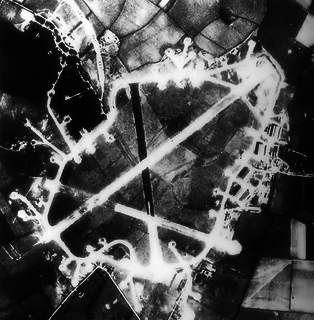Related Research Articles
The Royal Radar Establishment was a research centre in Malvern, Worcestershire in the United Kingdom. It was formed in 1953 as the Radar Research Establishment by the merger of the Air Ministry's Telecommunications Research Establishment (TRE) and the British Army's Radar Research and Development Establishment (RRDE). It was given its new name after a visit by Queen Elizabeth II in 1957. Both names were abbreviated to RRE. In 1976 the Signals Research and Development Establishment (SRDE), involved in communications research, joined the RRE to form the Royal Signals and Radar Establishment (RSRE).

The Royal Aircraft Establishment (RAE) was a British research establishment, known by several different names during its history, that eventually came under the aegis of the UK Ministry of Defence (MoD), before finally losing its identity in mergers with other institutions.
The Royal Signals and Radar Establishment (RSRE) was a scientific research establishment within the Ministry of Defence (MoD) of the United Kingdom. It was located primarily at Malvern in Worcestershire, England. The RSRE motto was Ubique Sentio.
The Defence Research Establishments were a number of separate UK Ministry of Defence Research Establishments, dating back to World War II, World War I, or even earlier. Each establishment had its own head; known as the Director or the Superintendent. Prior to the formation of the Ministry of Defence each of the three Services, i.e. the Royal Air Force, the Admiralty and the War Office, had their own research establishments; although some establishments had tri-service functions.
The Defence Evaluation and Research Agency (DERA) was a part of the UK Ministry of Defence (MoD) between 1995 and 2 July 2001. At the time it was the United Kingdom's largest science and technology organisation. It was regarded by its official history as 'a jewel in the crown' of both government and industry.
Qinetiq is a British multinational defence technology company headquartered in Farnborough, Hampshire, England. It is the world's 52nd-largest defence contractor measured by 2011 defence revenues, and the sixth-largest based in the United Kingdom.

Farnborough Airport is an operational business/executive general aviation airport in Farnborough, Rushmoor, Hampshire, England. The 310-hectare (770-acre) airport covers about 8% of Rushmoor's land area.

RAE Bedford was a research site of the Royal Aircraft Establishment between 1946 and 1994. It was located near the village of Thurleigh, north of the town of Bedford in England and was the site of aircraft experimental development work.
Sir John Alexander Raymond Chisholm is a British engineer who was chairman of the Medical Research Council and QinetiQ.

The Defence Science and Technology Laboratory (Dstl) is an executive agency of the Ministry of Defence of the United Kingdom. Its stated purpose is "to maximise the impact of science and technology for the defence and security of the UK". The agency is headed by Doug Umbers as its (interim) Chief Executive, with the board being chaired by Adrian Belton. Ministerial responsibility lies with the Minister for Defence Procurement.

MoD Boscombe Down(ICAO: EGDM) is the home of a military aircraft testing site, on the southeastern outskirts of the town of Amesbury, Wiltshire, England. The site is managed by QinetiQ, the private defence company created as part of the breakup of the Defence Evaluation and Research Agency (DERA) in 2001 by the UK Ministry of Defence (MoD).

Fort Halstead is a research site of Dstl, an executive agency of the UK Ministry of Defence. It is situated on the crest of the Kentish North Downs, overlooking the town of Sevenoaks, southeast of London. Originally constructed in 1892 as part of a ring of fortresses around London, Fort Halstead was to be staffed by volunteers in the event of a crisis.

Royal Air Force Thurleigh or more simply RAF Thurleigh is a former Royal Air Force station located 5 miles (8.0 km) north of Bedford, Bedfordshire, England. Thurleigh was transferred to the United States Army Air Forces Eighth Air Force on 9 December 1942 and designated Station 111, and used for heavy bomber operations against Nazi Germany.
The Aeroplane and Armament Experimental Establishment (A&AEE) was a research facility for British military aviation from 1918 to 1992. Established at Martlesham Heath, Suffolk, the unit moved in 1939 to Boscombe Down, Wiltshire, where its work continues following privatisation as part of the Qinetiq company.
The National Gas Turbine Establishment in Farnborough, part of the Royal Aircraft Establishment (RAE), was the prime site in the UK for design and development of gas turbine and jet engines. It was created by merging the design teams of Frank Whittle's Power Jets and the RAE turbine development team run by Hayne Constant. NGTE spent most of its lifetime as a testing and development centre, both for experimental developments and to support commercial engine companies.
The Rotary Wing Test and Evaluation Squadron (RWTES) is a tri-service UK military organisation based at MoD Boscombe Down, Wiltshire. Primarily, the squadron is responsible for test and evaluation of rotary wing aircraft and equipment, or their associated modifications.
A trading fund is an executive agency, government department or often simply a part of a department, that enables the department to handle its own revenues and expenses separately from overall government finances and more like a business, as opposed to having to obtain funding from the government's legislature and feeding income back into its treasury. A Hong Kong governmental study of trading funds in the UK and Hong Kong describes their nature and purpose as follows:
A trading fund is a financial and accounting framework established by law to enable a government department, or part of a department, to adopt certain accounting and management practices common in the private sector. [The fund] operates on a self-financing basis and does not need to regularly seek funding from the legislature to finance its daily operations after its establishment... the intention [is that such] an institutional change would provide the appropriate flexibility in resource management and nurture a new working culture to improve services in terms of both quality and cost-effectiveness.
The Military Vehicles and Engineering Establishment (MVEE) was a British defence research unit on Chobham Lane, Chertsey in Surrey. It was responsible for many innovations in armoured vehicle design, including ceramic Chobham armour.

The Admiralty Compass Observatory, originally known as the Compass Branch (1842–1917) and later known as the Compass Department (1917–1968) and Compass Directorate (1968–1971) was established in 1842 to provide the Royal Navy with services for the design, development, inspection, testing and repair of compasses and certain other instruments. It subsequently undertook requirements for the other services as appropriate. It existed until 1971 when it was absorbed within the Admiralty Surface Weapons Establishment.

The Military Engineering Experimental Establishment (MEXE) was a British defence research unit. It was formed from the Experimental Bridging Establishment in 1946 and was amalgamated with the Fighting Vehicles Research and Development Establishment to form the Military Vehicles and Engineering Establishment in 1970. MEXE developed the MEXE method, the MEXE probe and the MEXE system.
References
- ↑ "Defence Evaluation and Research Agency (DERA) and its immediate predecessors: Reports and Files 1991–2001". 2001. Archived from the original on 22 June 2011. Retrieved 10 September 2011.
- ↑ Lake 1999, p. 57.